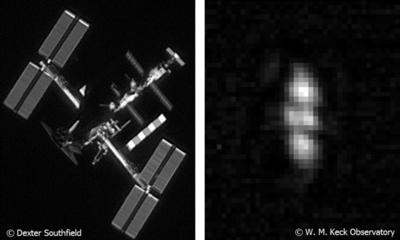Issues RFI Seeking Ideas For Revolutionary Telescope System
Imaging of Earth from satellites in space has vastly improved in recent years. But the opposite challenge—using Earth-based systems to find, track and provide detailed characterization of satellites and other objects in high orbits—has frustrated engineers even as the need for space domain awareness has grown. State-of-the-art imagery of objects in low Earth orbit (LEO), up to 1,200 miles high, can achieve resolution of 1 pixel for every 10 cm today, providing relatively crisp details. But image resolution for objects in geosynchronous Earth orbit (GEO), a favorite parking place for space assets roughly 22,000 miles high, drops to just 1 pixel for every 2 meters, meaning many GEO satellites appear as little more than fuzzy blobs when viewed from Earth.

Enabling LEO-quality images of objects in GEO would greatly enhance the nation’s ability to keep an eye on the military, civilian and commercial satellites on which society has come to depend, and to coordinate ground-based efforts to make repairs or correct malfunctions when they occur.
Achieving that goal will require radical technological advances because traditional or “monolithic” telescopes designed to provide high-resolution images of objects in GEO would be too physically and financially impractical to construct. For instance, achieving image resolution of 1 pixel to 10 cm for objects at GEO would require the equivalent of a primary imaging mirror 200 meters in diameter—longer than two football fields. To overcome these limitations and expedite the possible development of revolutionary benefits, DARPA has issued a Request for Information (RFI) seeking specific technological information and innovative ideas demonstrating the potential for high-resolution imaging of GEO objects.
The RFI envisions a ground-based system that would be a sparse-aperture interferometer, which instead of relying upon one primary imaging mirror would measure the interference patterns of light detected by multiple smaller telescopes, from which a composite image could be derived. The GEO-imaging interferometer would rely on only passive (solar) illumination or thermal self-emission from imaged objects and could require the use of many telescopes, quite likely in a reconfigurable array. Responses to the RFI may inform a potential future program.
“We’re looking for ideas on how to create ground-based sparse aperture telescope systems that would provide GEO imagery as clear as current LEO imagery,” said Lindsay Millard, DARPA program manager. “This ‘100x zoom lens’ would provide the first ground-based capability to quickly assess anomalies that happen to GEO satellites, such as improperly deployed antennas or partially unfurled solar panels. With that capability, satellite owners could identify and fix problems more effectively and increase their satellites’ operating lifetimes and performance.”
“The image resolution this RFI envisions—down to a milli-arcsecond, or approximately one-3.6-millionth of a degree—would be up to 100 times more powerful than the current state of the art,” Millard continued. “Beyond helping us achieve our immediate needs on orbit, that improvement could significantly advance astronomy research, helping us learn about black holes and galaxy dynamics, as well as characterizing nearby exoplanets and detecting more-distant ones.”
The RFI invites short responses (3 pages or fewer) that explore some or all of the following technical areas:
- Direct atmospheric phase measurement: Information on methods to directly and locally measure atmospheric conditions to enable collection of clear data at the distances between apertures envisioned for the system, as well as decrease system complexity and infrastructure requirements
- Meter-class replicated optics and compensation of low-quality optics: Information about replicated optics technology applicable to telescopes 0.5 meter to 5 meters in diameter to potentially mitigate the need for high-precision fabrication, and reduce fabrication cost and timescales by an order of magnitude over conventional optical manufacturing methods
- Image-formation algorithms: Ideas on novel image formation algorithms and post-processing techniques that would enable reliable image reconstruction from sparse aperture or similar imaging systems
- Interferometry demonstration testbeds: Information about existing facilities that may provide economical and expedient means of demonstrating such technologies by utilizing existing infrastructure
To maximize the pool of innovative proposal concepts, DARPA strongly encourages participation by non-traditional performers, including small businesses, academic and research institutions and first-time government contractors. For this RFI, DARPA particularly seeks expertise in astronomy, novel optical design and quantum optics as it applies to long-baseline interferometry.
Responses are due Friday, July 3, 2015 to DARPA-SN-15-38@darpa.mil by 4:00 PM Eastern Time. All technical and administrative correspondence and questions regarding this announcement and how to respond should be sent to DARPA-SN-15-38@darpa.mil.
 ANN's Daily Aero-Term (05.01.24): Say Altitude
ANN's Daily Aero-Term (05.01.24): Say Altitude ANN's Daily Aero-Linx (05.01.24)
ANN's Daily Aero-Linx (05.01.24) Classic Aero-TV: Korean War Hero Twice Reborn
Classic Aero-TV: Korean War Hero Twice Reborn Airborne 04.29.24: EAA B-25 Rides, Textron 2024, G700 Deliveries
Airborne 04.29.24: EAA B-25 Rides, Textron 2024, G700 Deliveries Airborne Affordable Flyers 05.02.24: Bobby Bailey, SPRG Report Cards, Skydive!
Airborne Affordable Flyers 05.02.24: Bobby Bailey, SPRG Report Cards, Skydive!



